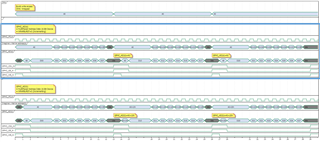Hi Team,
My customer has questions regarding GPMC as below.
- In DMA Wrapped settings, when setting GPMC to Incrementing (not wrapped) Csi, what will happen to GPMC_AD output when 16bit/16byte burst write and 128 byte write? (Which of the three below?)
- Valid address becomes the same address every burst writing cycle
- Valid address becomes +16bytes address every burst writing cycle
- None of the above
- When the GPMC_WAIT pin is valid, what is the relationship between CYCLETIME counter and GPMC setting values?
- When the CYCLETIME counter is on freeze, is it accurate to say that RDACCESSTIME, WRACCESSTIME, PAGEBURSTACCESSTIME are affected? Or will CSONTIME and CSOFFTIME also be affected when CYCLETIME counter is on freeze?
Best regards,
Mari Tsunoda


